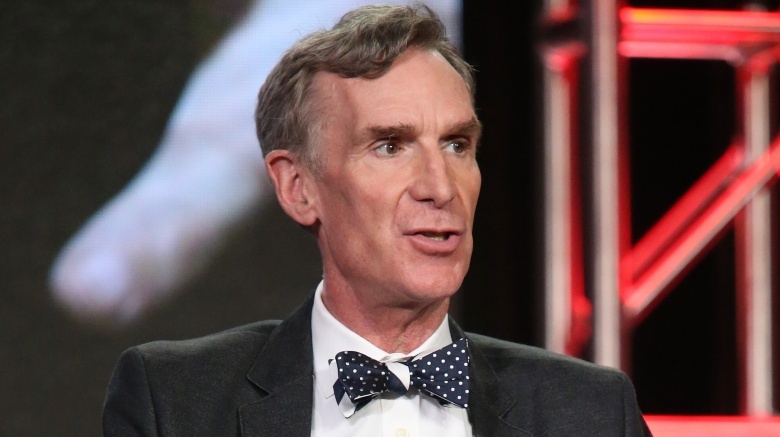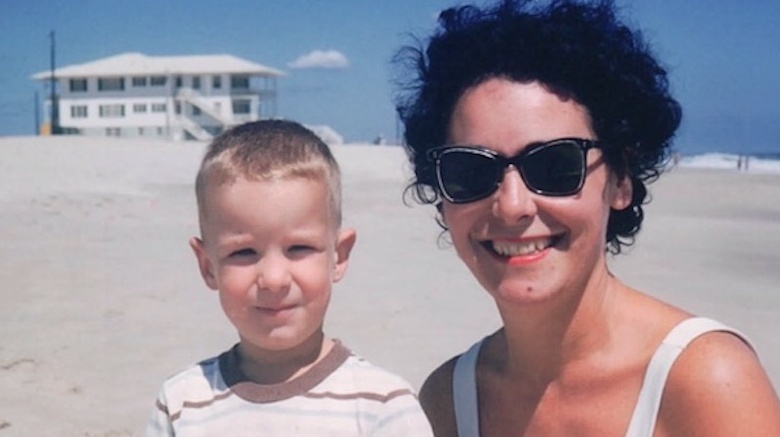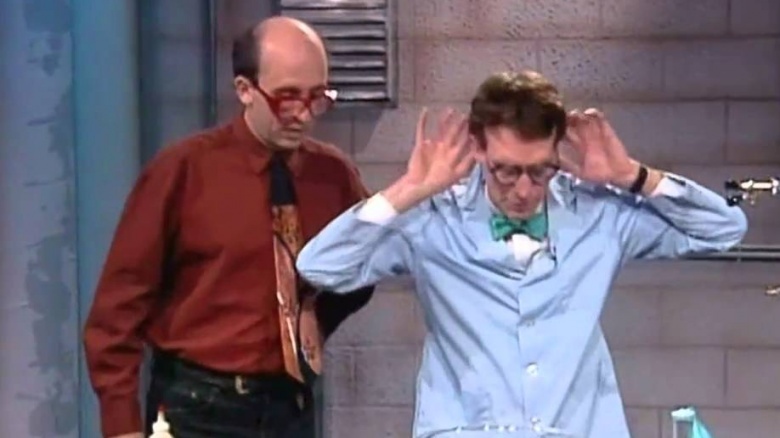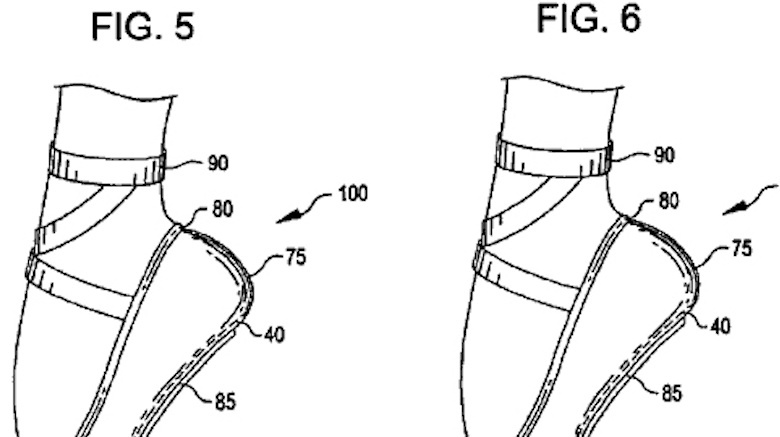The Untold Truth Of Bill Nye The Science Guy
Part of a small pop culture club that also includes Carl Sagan and Neil deGrasse Tyson, Bill Nye is respected and beloved across the diametrically opposite worlds of science and entertainment. Scientists aren't often celebrities and celebrities aren't often scientists, but when you can combine a love of knowledge with the gift of a charismatic screen presence and a knack for making seemingly complex concepts feel fun and easy to explore, brainy superstardom awaits. As proof, just look at the millions of kids who grew up watching the 1993-1998 PBS series Bill Nye the Science Guy, which instilled in its young audience both a love of science and a general curiosity about the world.
But Bill Nye isn't just a television guy. As it turns out, he's lived a very rich and varied life, both before and after the show, and we've rounded up some of the more fascinating facts about his journey to pop culture science icon and beyond. This is the untold truth of Bill Nye the Science Guy.
He comes from real scientists
Bill Nye wasn't just an actor playing a scientist on TV—he has an impressive scientific background, not to mention a science-minded family. Nye's mother, Jacqueline Jenkins-Nye, worked for the U.S. Navy as a codebreaker during World War II. Working with the Enigma machines (just like Alan Turing, as depicted in the movie The Imitation Game), Jenkins-Nye helped intercept and decipher the code that the Nazis used to transmit messages. Nye himself graduated from the Ivy League's Cornell University with a degree in mechanical engineering. (He even studied under Carl Sagan.) Nye parlayed that degree into an engineering position at Boeing, the massive Seattle-based airplane manufacturer. While there, he developed the hydraulic pressure resonance suppressor, which is part of what made the 747 such a powerful and speedy aircraft. It's still used on airplanes today.
He wanted to be a comedian
In 1978, Bill Nye entered a Steve Martin look-alike contest...and won. And so, like Martin, he started doing stand-up comedy—working at Boeing during the day and performing in clubs around Seattle at night. By 1986, he'd developed his chops enough that he started submitting jokes to Almost Live, a long-running Seattle TV sketch comedy show (think Saturday Night Live, but with more jokes about the rain). Host Ross Shafer thought Nye's material was okay, but had a better idea: Have Nye do humorous scientific demonstrations on the show. Almost immediately, the two came up with the name "Bill Nye the Science Guy." (Nye also appeared in other sketches on Almost Live. He even had a recurring character: Speedwalker, a superhero who speed-walked instead of flew.)
He's the ultimate Ultimate player
Bill Nye isn't just a scientist, he's also an athlete. While attending Cornell in the early 1970s, he joined the university's first-ever Ultimate team, the Cornell Buds. (What's Ultimate? It's a sport that involves passing a flying disc to teammates until it's successfully thrown past goalposts.) After moving to Seattle, he helped form the first-ever men's Ultimate team in the Seattle area. Additionally, he was the captain of the "Olympic Windjammers." Why? According to Nye, "I was captain because I had a phone. I had a phone at home. And an answering machine. And a pencil and a pen and paper. I had all that technology." He also got hurt pretty badly on a couple of occasions. During play he dislocated a shoulder, and another time an opposing player broke his nose.
Bill Nye the Science Guy was a spinoff of Back to the Future
Bill Nye's demonstrations on Almost Live led to a higher profile gig: as the almost always silent assistant of Doc Brown (Christopher Lloyd) on CBS's 1991-93 Saturday morning show Back to the Future: The Animated Series. In wrap-around live action segments for the cartoon, Lloyd would perform a science experiment as Doc Brown. Acting as the Beaker to Doc's Bunsen Honeydew: Bill Nye. CBS liked the segments so much—in which Nye was billed as "The Science Guy"— that it created Bill Nye the Science Guy, which hit the air just a few months after Back to the Future was canceled. This time, he actually got to talk.
He sent a sundial to Mars
Bill Nye's father, Ned Nye, was imprisoned in a Japanese internment camp during World War II. To pass the long hours in which he had nothing to do, he spent a lot of time building sundials out of old fence posts, and used pebbles to mark the hour lines as they passed. That developed into a lifelong obsession with sundials, both building and studying them, and he passed that on to his son. Bill, in turn, passed along that keen knowledge and interest to NASA. After years of persuasion, the space agency allowed Nye to lead the team that developed the MarsDial to be used on the Mars Exploration Rovers. They're essentially sundials that track time on Mars—which, in turn, helps calibrate the rovers' cameras for full-color photographs.
He's a failed astronaut
Before his involvement with NASA on the Mars Rover and the sundials, Bill Nye tried many times in his youth to enter the space agency's astronaut training program. All four times he applied, he didn't make the grade. Nye believes it's because he hadn't received enough education as is typically required of astronauts—he doesn't have a Ph.D., only a Bachelor's degree. (And his six honorary doctorates apparently don't count.)
He holds a variety of patents
Bill Nye may have helped invent a sundial for use on another planet and an element of a jet airplane, but he holds patents for some slightly more accessible inventions. In 1994, during the run of Bill Nye the Science Guy, Nye developed an educational magnifying glass. It's made from a plastic pouch that forms a lens when filled with water. In 2002, Nye received a patent for a new kind of ballet shoe that promised to provide more foot support to a ballerina while dancing en pointe (on the tips of their toes).
He's had a tumultuous personal life
In 2005, Bill Nye read Mozart in the Jungle, a memoir by classical oboist Blair Tindall about her years as a member of the New York Philharmonic Orchestra. (It's the basis of Amazon Prime's Golden Globe-winning comedy series.) He contacted her, one thing lead to another, and they fell in love. Nye and Tindall married in 2006 with a star-studded wedding officiated by The Purpose Driven life author Rick Warren; cellist Yo Yo Ma played as Tindall walked down the aisle. Just seven weeks later, the marriage dissolved—Nye received a letter from the state of California informing them that their marriage license had been invalid. The couple decided to split up altogether. Not long after, Nye spotted a figure dressed in all black wandering around his garden—it was Tindall, and he alleges that she attempted to destroy the plants in his garden with weed killer. Nye filed for a restraining order against his ex-not-quite-wife.
He's a highly competitive environmentalist
Bill Nye once lived in the same Studio City, California neighborhood as actor and fervent environmentalist Ed Begley, Jr. The two engaged in a friendly, years-long contest over which man could live the "greenest" or most environmentally-friendly life. Neighbors say Nye actually started it, wanting to "best Ed Begley at his own game." To counter Begley's electric car, outdoor solar oven, and picket fence made from recycled plastic milk cartons, Nye installed solar panels on his house, bought rain barrels, and planted a vegetable garden. Parts of the "battle" were taped as part of Begley's reality TV series Living With Ed.
He fights for science
In 2014, Bill Nye served as the representative for all of science regarding the origins of the universe. In a public debate held at the Creation Museum in Kentucky called "Is Creation a Viable Model of Origins?" Nye argued that the universe came into spontaneous being billions of years ago. Taking the side of intelligent design was Australian minister Ken Ham. Over the course of the two-and-a-half hour debate, Ham accused Nye and others of "hijacking" science; Nye countered Ham's claim that the planet is only a few thousand years old by offering up geological and astronomical data suggesting the Earth is billions of years old. More than three million people watched the debate live over the internet.









